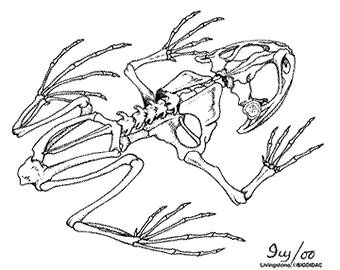Study and Removal of the Frog's Brain


Starting at the most anterior part of the head, the olfactory nerves connect to the nostrils and then to the olfactory lobes (A) where odors are processed. Just posterior to the olfactory lobes are two oval structurs, the cerebrum (B), and it is the frog's thinking center.
Posterior to the cerebrum are the optic lobes (C), which function in vision. The ridge just behind the optic lobes is the cerebellum (D), it is used to coordinate the frog's muscles and maintain balance. Posterior to the cerebellum is the medulla oblongata (E) which connects the brain to the spinal cord (F).

Brain Part |
Function |
Letter |
Cerebellum |
||
Cerebrum |
||
Olfactory Lobe |
||
Optic Lobe |
||
Medulla Oblongata |
Removal of the Frog's Brain: Turn the frog dorsal side up. Cut away the skin and flesh on the head from the nose to the base of the skull. With a scalpel, scrape the top of the skull until the bone is thin and flexible. Be sure to scrape AWAY from you, carefully chip away the roof of the skull to expose the brain. To receive extra credit for removing the brain, you must present it to me on a paper towel with all structures above visible.
FROG BONES

The lower leg of the frog is
a muscular leg that the frog uses for jumping. There are 3 main sets of bones
in the lower leg. The femur is found in the upper thigh, and the tibiofibula is found in the lower part of the leg. The foot and ankle are made of the tarsals and metatarsals (toes).
To expose the frog's leg bones you must remove the thigh muscle - the biceps femorus and the calf muscle - the gastrocnemius. You can leave the Achilles tendon intact (this tendon connects the muscle to the bone). The tarsals and metatarsals do not need to be exposed. To receive extra credit, clean your bones by removing the surrounding muscle. Bring the two bones on a paper towel. Good Luck!
**Label the leg bones: Femur, Tibiofibula, tarsals, metatarsals, pelvic girdle**
Other Frog Dissection Pages
External Anatomy of Frog
Frog Dissection (Main)
Frog Dissection Alternative
Ultimate Frog Review